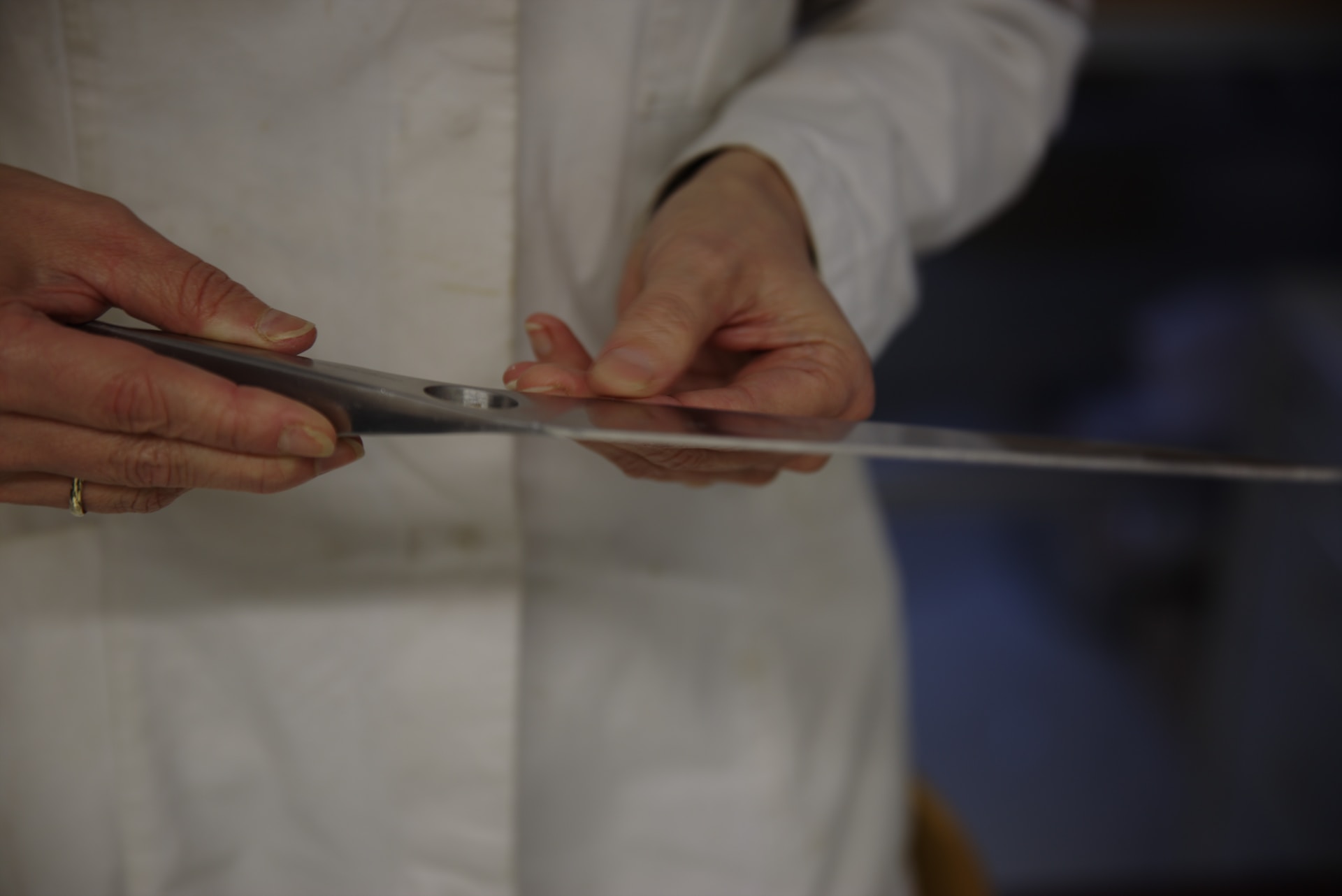Hello everyone! In our daily lives, we frequently use knives to “dress” our ingredients. But have you ever pondered how the artistry and philosophy behind these blades impact our existence? Today, I’d like to share with you about the balance point of Japanese knives and why it holds such significant importance in Japanese culture.

1. What is the Balance Point of a Knife?
In simple terms, the balance point of a knife is the central equilibrium between the knife and your hand when you grip it. When you pinch at this spot, the knife feels neither heavy nor too light. It’s a unique trait of every knife, determining the experience of its usage and, indirectly, its craftsmanship and value.
2. Why is the Balance Point So Important?
Imagine holding a knife where every movement, every twist, and every slice is intimately connected to that blade. The balance point of a knife is akin to the waist of a dancer, playing a crucial role in the fluidity and force of the entire motion. If the balance point deviates from its ideal location, it can affect the knife’s handling and performance.
3. Why Do the Japanese Place So Much Emphasis on the Balance of a Knife?
The pursuit of detail is ubiquitous in Japanese culture. Be it the art of Ikebana (flower arrangement), the tea ceremony, or Bushido (the way of the warrior), every craft strives for perfection and harmony. Japanese knife makers are not just artisans; they are artists. They believe that a perfect knife isn’t just a combination of materials and techniques but a harmonious dance with its user.
Moreover, for the Japanese samurai, the sword is not just a weapon; it embodies their spirit. A blade that seamlessly melds with the body can better showcase a samurai’s skill and courage.
What Determines the Balance Point of a Knife?
The balance point of a knife is determined by several factors. These factors play a role in the manufacturing process of the knife, influencing its weight distribution and overall design. Here are the primary factors that dictate a knife’s balance point:
- Density of Materials: The density of the materials used for the blade and the handle affects their weight. For instance, some high-quality knives might use a denser, heavier steel for the blade, while the handle could be made of lightweight wood or synthetic materials.
- Shape and Size of the Blade: Different shapes and lengths of blades have different weight distributions. For example, the balance point of a broad cleaver blade might differ from that of a slender slicing knife.
- Length and Shape of the Handle: The design of the handle has a direct impact on the knife’s balance point. A longer or heavier handle might shift the balance point toward the handle.
- Decorations and Add-ons: Some knives might include decorative elements like engravings, inlays, or other add-ons, which could affect the knife’s weight and balance.
- Fillings Inside the Handle: Some knife handles might have filling materials or metal parts inside, which can influence the overall weight and balance point of the knife.
- Manufacturing Process: The techniques and craftsmanship involved can also affect the balance of a knife. For example, a hand-crafted knife might have a different balance point compared to a factory-made one because each handmade knife is unique and might have slight variations.

How to Find the Balance Point of a Knife?
Finding the balance point of a knife isn’t particularly challenging, but it does require careful attention and some technique. Below are steps and tips to assist you in determining a knife’s balance point:
1.Safety First: When trying to locate the balance point of a knife, always prioritize your safety. Opt for a stable and non-slip surface, and make sure your hands are dry to prevent any accidental slips that might lead to injuries.
2.Position the Blade Horizontally: Place the knife horizontally on a table or another flat surface, ensuring the blade’s edge doesn’t come into contact with the surface.
3.Balance Test:
- Lay the knife horizontally on a pointed or edged object, like a pencil, chopstick, or any elongated item. Make sure this object is firm and secure.
- Gently shift the knife back and forth until it remains stable without tipping over. When the knife stands still and balanced, you’ve located its balance point.
4.Mark the Balance Point: Once identified, you can mark the balance point with a durable marker or sticker for future reference. However, be mindful that frequently used knives should not have stickers on them for extended periods as this could leave adhesive residue.
5.Verification: Re-balance the knife multiple times to confirm that the identified point is indeed its balance point.
Understanding and pinpointing the balance point of a knife can aid in better handling and usage, especially during precise cuts or complex maneuvers. Knowing the knife’s balance point enables smoother and more natural use, enhancing the efficiency and safety of the tool.
In our daily routines, we may not be as attuned to the balance point of a knife as a Japanese samurai would be. However, when we delve deeper into the culture and emotions behind it, we begin to treasure every tool we hold and develop a profound respect for the artisans who infuse art and emotion into our lives.
Thank you for reading. I hope this has given you some insights. Whether it’s tools or life, I hope you find your perfect “balance point.”
